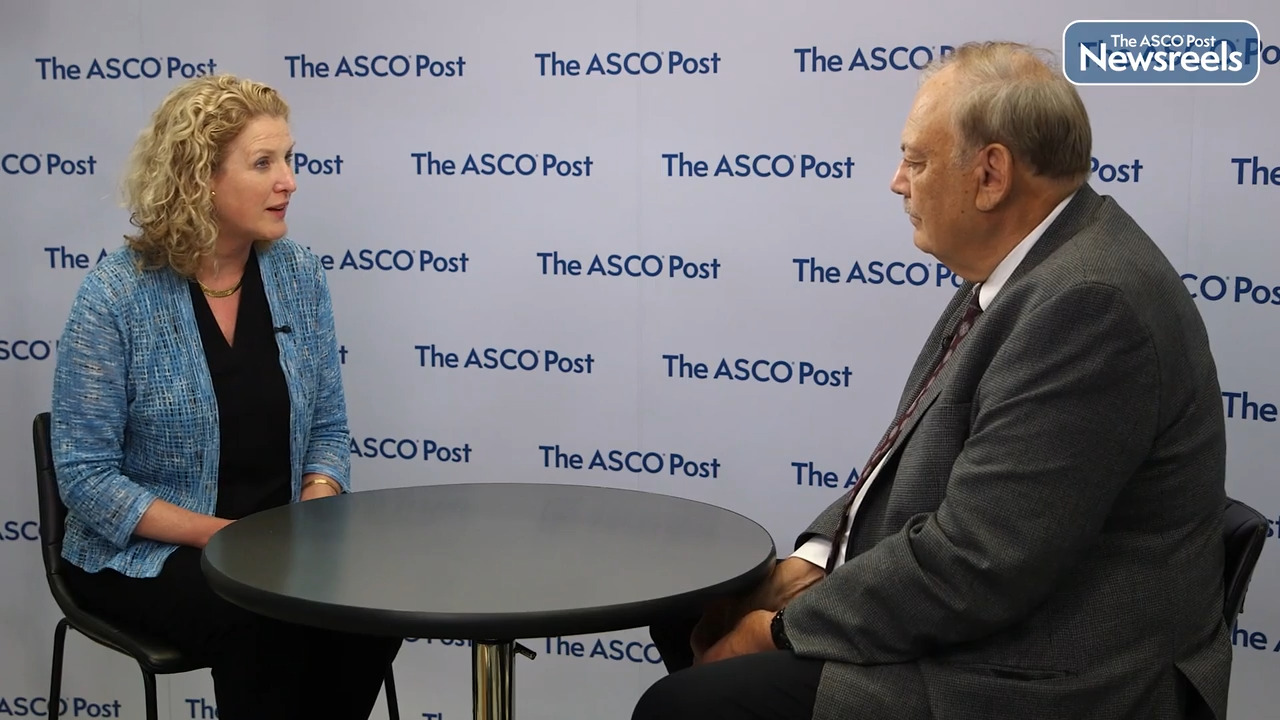Largest Human Breast Cell Atlas to Date May Offer Insights Into Mammary Biology
Researchers have created the world’s largest and most comprehensive atlas of normal breast tissue—the Human Breast Cell Atlas—which may provide an unprecedented understanding of mammary biology and help identify therapeutic targets for diseases such as breast cancer, according to a recent study...
Amcenestrant vs Standard Endocrine Therapy in ER-Positive, HER2-Negative Advanced Breast Cancer
In the phase II AMEERA-3 trial reported in the Journal of Clinical Oncology, Sara M. Tolaney, MD, MPH, and colleagues found that the selective estrogen receptor degrader amcenestrant did not improve progression-free survival vs physician’s choice of endocrine therapy in patients with estrogen...
FDA Approves Iopromide Injection for Contrast-Enhanced Mammography
Iopromide-300 and -370 (Ultravist), an iodine-based contrast agent, has been approved by the U.S. Food and Drug Administration (FDA) for contrast-enhanced mammography—making it the only contrast agent approved for this indication. The product can be used to visualize known or suspected lesions of...
Potential Role of ChatGPT-4 in Selecting Appropriate Imaging Tests for Breast Cancer Screenings and Breast Pain
Investigators have found that artificial intelligence (AI) language models like OpenAI’s ChatGPT may accurately identify appropriate imaging tests for breast cancer screenings and breast pain, according to a recent study published by Rao et al in the Journal of the American College of Radiology....
Guideline Update Provides New Testing and Treatment Recommendations for Patients With ER-Positive, HER2-Negative Metastatic Breast Cancer With ESR1 Mutations
Testing for the emergence of ESR1 mutations should be routine at disease recurrence or progression for patients with estrogen receptor (ER)-positive, HER2-negative metastatic breast cancer whose disease is being managed with endocrine therapy, according to an ASCO guideline rapid recommendation...
Dose-Escalated Simultaneous Integrated Boost Radiotherapy for Early-Stage Breast Cancer
In the phase III IMPORT HIGH trial reported in The Lancet, Charlotte E. Coles, FRCR, and colleagues found little difference in ipsilateral breast tumor relapse rates with adjuvant dose-escalated simultaneous integrated boost radiotherapy vs lower-dose sequential boost radiotherapy in patients with...
Adjuvant Treatment With Ribociclib Reduces Risk of Recurrence in Hormone Receptor–Positive, HER2-Negative, Early-Stage Breast Cancer
The addition of the CDK4/6 inhibitor ribociclib to endocrine therapy significantly improved invasive disease–free survival in women with hormone receptor–positive, HER2-negative, early-stage breast cancer. These results of the phase III NATALEE trial were reported by lead author Dennis J. Slamon,...
PET/CT-FDG vs Conventional Staging in Locally Advanced Breast Cancer
In a Canadian study reported in the Journal of Clinical Oncology, Dayes et al found that positron-emission tomography/computed tomography–fluorodeoxyglucose (PET/CT-FDG) improved the detection of distant metastasis vs conventional staging in patients with locally advanced breast cancer. It also...
Aromatase Inhibitors May Limit Effectiveness of Weight Loss Medications in Breast Cancer Survivors
Aromatase inhibitors may interfere with the efficacy of weight loss medications in breast cancer survivors, according to a new study presented by Fansa et al at the 2023 Endocrine Society Annual Meeting. Background Aromatase inhibitors are designed to block the activity of the aromatase enzyme,...
Older Breast Cancer Survivors May Experience Accelerated Aging, Worse Functional Outcomes Following Chemotherapy
Investigators have found that older breast cancer survivors—particularly those exposed to chemotherapy—may experience greater epigenetic aging and poorer outcomes than those without a history of cancer, according to a new study published by Rentscher et al in Cancer. Background Epigenetic aging...
Adherence to Cancer Prevention Lifestyle Recommendations Before, During, and After Treatment for High-Risk Breast Cancer: Association With Recurrence and Mortality
In a study reported in JAMA Network Open, Cannioto et al found that greater adherence to cancer prevention lifestyle recommendations before, during, and after treatment for high-risk breast cancer was associated with a reduced risk of disease recurrence and all-cause mortality. Study Details The...
Impact of Historic Redlining Practices on Cancer Screening Rates
Although redlining was outlawed more than 50 years ago, individuals who currently live in historically redlined areas may be less likely to be screened for breast cancer, colorectal cancer, and cervical cancer than individuals who live in areas not associated with redlining practices, according to...
Study Evaluates Clinical Utility of Novel Liquid Biopsy-Breast Cancer Methylation Prototype Assay
A novel, automated liquid biopsy test—the Liquid Biopsy for Breast Cancer Methylation assay—may be effective at predicting early disease progression and potential survival outcomes in patients with metastatic breast cancer after as little as 1 month of treatment, according to a study published by...
Mortality Rates From Second Cancers in Hispanic and Non-Hispanic Black Breast Cancer Survivors
Hispanic and non-Hispanic Black breast cancer survivors may experience higher rates of mortality after being diagnosed with a second primary cancer than breast cancer survivors of other ethnic and racial groups, according to a new study published by Deng et al in the Journal of the National Cancer...
Study Finds Preoperative MRI Does Not Significantly Impact Margin Status in Patients With Breast Cancer
The use of preoperative magnetic resonance imaging (MRI) did not significantly reduce positive margins after breast-conserving surgery, according to data presented during a press briefing at the 2023 American Society of Breast Surgeons Annual Meeting.1 Although MRI has been shown to detect...
Interruption of Endocrine Therapy to Attempt Pregnancy in Women With Hormone Receptor–Positive Early Breast Cancer
In a study reported in The New England Journal of Medicine, Ann H. Partridge, MD, MPH, of Dana-Farber Cancer Institute, and colleagues found that temporary interruption of adjuvant endocrine therapy to attempt pregnancy was not associated with increased short-term risk of breast cancer events among ...
Two Studies of Atezolizumab-Based Regimens in Early-Stage, Triple-Negative and HER2-Positive Breast Cancers
Immunotherapy regimens involving the PD-L1 monoclonal antibody atezolizumab have demonstrated promising results in patients with early-stage, triple-negative breast cancer and HER2-positive breast cancer, according to a pair of studies presented at the European Society for Medical Oncology (ESMO)...
Endocrine Therapy Switch With or Without Ribociclib After Disease Progression on Endocrine Therapy and CDK4/6 Inhibition for Metastatic Breast Cancer
In the phase II MAINTAIN trial reported in the Journal of Clinical Oncology, Kevin Kalinsky, MD, MS, and colleagues found that a switch in endocrine therapy plus continued CDK4/6 inhibitor treatment with ribociclib was associated with improved progression-free survival in patients with hormone...
Allostatic Load and Mortality in Patients With Breast Cancer
In a study reported in JAMA Network Open, Samilia Obeng-Gyasi, MD, MPH, and colleagues found that allostatic load—defined as “a cumulative measure of physiologic damage secondary to cognitive-emotional responses and perceptions to socioenvironmental stressors (ie, low socioeconomic status)”—was...
Race and Ethnicity May Affect 21-Gene Recurrence Score in Patients With Estrogen Receptor–Positive Breast Cancer
Investigators have found that race and ethnicity may affect the 21-gene recurrence score in patients with early-stage, estrogen receptor–positive breast cancer, according to new findings presented by Gill et al at the 2023 ASCO Annual Meeting (Abstract 511). Background The 21-gene recurrence...
Lisa A. Carey, MD, and Javier Cortes, MD, PhD, on HER2-Positive Early Breast Cancer: Chemotherapy De-escalation Under Study in PHERGain Trial
Lisa A. Carey, MD, of the University of North Carolina at Chapel Hill, and Javier Cortes, MD, PhD, of the International Breast Cancer Center and Universidad Europea de Madrid, discuss phase II findings showing that one in three patients with HER2-positive early breast cancer may safely omit chemotherapy. Among the chemotherapy-free patients treated with trastuzumab and pertuzumab, the 3-year invasive disease–free survival was 98.8%, with no distant metastases (Abstract LBA506).
Lisa A. Carey, MD, and Dennis J. Slamon, MD, PhD, on Early Breast Cancer: Findings From the NATALEE Trial on Ribociclib Plus Endocrine Therapy
Lisa A. Carey, MD, of the University of North Carolina at Chapel Hill, and Dennis J. Slamon, MD, PhD, of the University of California, Los Angeles, discuss phase III study findings on ribociclib plus endocrine therapy as adjuvant treatment in patients with hormone receptor–positive, HER2-negative early breast cancer. When added to standard-of-care endocrine therapy, ribociclib improved invasive disease–free survival with a well-tolerated safety profile (Abstract LBA500).
Jennifer A. Ligibel, MD, on Early Breast Cancer and Weight Loss: Results From the BWEL Trial
Jennifer A. Ligibel, MD, of Dana-Farber Cancer Institute, discusses a telephone-based weight loss intervention that induced clinically meaningful weight loss in patients with breast cancer who had overweight and obesity, across demographic and tumor factors. Additional tailoring of the intervention may possibly enhance weight loss in Black and younger patients as well (Abstract 12001).
Adding Ribociclib to Endocrine Therapy May Reduce Recurrence Risk in Patients With Hormone Receptor–Positive, HER2-Negative Early-Stage Breast Cancer
Adding the CDK4/6 inhibitor ribociclib to endocrine therapy resulted in a significant improvement in invasive disease–free survival for patients with hormone receptor–positive, HER2-negative early-stage breast cancer. Findings from the phase III NATALEE trial were presented by Dennis J. Slamon, MD, ...
HER3-Targeting Antibody-Drug Conjugates Show Encouraging Results in Breast Cancer Subtypes
Early-phase data from the SOLTI TOT-HER3 and ICARUS-BREAST01 trials suggest that the novel HER3-directed antibody-drug conjugate patritumab deruxtecan may have beneficial activity in patients with hormone receptor–positive/HER2-negative and triple-negative breast cancer subtypes, according to...
Incidence of Colorectal, Lung, and Breast Cancers May Be Rising Due to COVID-19–Related Screening Delays
Delays in cancer screenings during the COVID-19 pandemic may have resulted in lower reported incidences of colorectal, lung, and breast cancers, reflecting potentially high rates of undiagnosed cancer and later-stage diagnoses, according to a new study published by Romatoski et al in the Journal of ...
Addition of First-Line Dalpiciclib to Letrozole or Anastrozole in Hormone Receptor–Positive, HER2-Negative Advanced Breast Cancer
In an interim analysis of a Chinese phase III trial (DAWNA-2) reported in The Lancet Oncology, Zhang et al found that the addition of the CDK4/6 inhibitor dalpiciclib to letrozole or anastrozole improved progression-free survival as first-line treatment in patients with advanced hormone...
Telephone-Based Weight Loss Intervention for Patients With Breast Cancer and Overweight/Obesity
A randomized study by Jennifer A. Ligibel, MD, Director of the Leonard P. Zakim Center for Integrative Therapies and Healthy Living at Dana-Farber Cancer Institute, and Associate Professor of Medicine at Harvard Medical School, evaluating the impact of a telephone-based weight loss intervention in...
Playing a Doctor in a School Play Sparked an Early Desire to Become a Real Doctor for Sibylle Loibl, MD, PhD
For this installment of The ASCO Post’s Living a Full Life series, guest editor Jame Abraham, MD, FACP, spoke with Sibylle Loibl, MD, PhD, Chair of the German Breast Group (GBG) and Chief Executive Officer of the GBG Forschungs GmbH. Professor Loibl, Associate Professor of Obstetrics and Gynecology ...
Effect of HER2 Expression Levels on Survival Outcomes in Patients With Metastatic Breast Cancer Receiving Targeted Therapy Plus Endocrine Therapy
In a single-institution cohort study reported in JAMA Network Open, Jason A. Mouabbi, MD, and colleagues found no difference in survival outcomes between patients with hormone receptor–positive metastatic breast cancer with low vs no HER2 expression who received targeted therapy and endocrine...
Computer‐Aided Diagnosis May Improve Breast Ultrasound Performance
Deep learning–based computer-aided diagnosis on breast ultrasound may significantly improve radiologists’ diagnostic performance and reduce the frequency of benign breast biopsies, according to a new study published by He et al in the American Journal of Roentgenology. Compared with previous...
Surveillance Mammography Rates After Breast Cancer Treatment Remain High, Irrespective of Life Expectancy
Is regular surveillance with mammography important in older patients with breast cancer and a shortened life expectancy? A study of 44,475 patients with breast cancer found the practice—which may yield more harms than benefits—to be common. This study is unique in that it examined surveillance...
Assay Prediction of pCR in Patients With HER2-Positive Breast Cancer Treated With Neoadjuvant Paclitaxel, Trastuzumab, and Pertuzumab
In an analysis reported in JAMA Oncology, Waks et al found that the HER2DX assay performed well in predicting the likelihood of pathologic complete response (pCR) in patients with early HER2-positive breast cancer receiving de-escalated neoadjuvant treatment with paclitaxel, trastuzumab, and...
Expert Point of View: Sarah Blair, MD
Sarah Blair, MD, Professor and Vice Chair of the Department of Surgery at UC San Diego Health in California, offered her thoughts on the findings from these two studies. She first pointed to the growing body of data showing how nutrition and exercise programs can improve aerobic fitness, quality of ...
Exercise, Wellness Interventions in Early Breast Cancer Demonstrate Measurable Benefits—Even Economic Ones
Specialized exercise and wellness programs significantly elevated physical well-being and quality of life among patients with breast cancer while reducing the use of health-care resources in new research presented at the 2023 American Society of Breast Surgeons Annual Meeting. In one multicenter...
Trastuzumab/Pertuzumab Plus Neoadjuvant Paclitaxel or Endocrine Therapy in Hormone Receptor–Positive, HER2-Positive Early Breast Cancer
In a German phase II trial (WSG-TP-II) reported in JAMA Oncology, Gluz et al found that the addition of neoadjuvant paclitaxel monotherapy to trastuzumab/pertuzumab resulted in a higher pathologic complete response (pCR) rate in patients with hormone receptor–positive, HER2-positive early breast...
Potential Utility of Polygenic Risk Scores in Cancer Screening in the United Kingdom
In a modeling study reported in The Lancet Oncology, Huntley et al found that the extension of UK cancer screening programs for breast, prostate, and colorectal cancers to a polygenic risk score (PRS)-defined high-risk group of patients with cancer may improve cancer case detection and avoidance of ...
Long-Term Risk Prediction for Invasive Breast Cancer: AI System Plus Volumetric Density on Screening Mammography
In a study reported in the Journal of Clinical Oncology, Vachon et al found that the combination of an artificial intelligence (AI) imaging algorithm, together with measures of breast density on mammography screening, were capable of long-term prediction of risk of invasive breast cancer. As stated ...
Interruption of Adjuvant Endocrine Therapy to Attempt Pregnancy in Women With Breast Cancer
In a study reported in The New England Journal of Medicine, Ann H. Partridge, MD, MPH, and colleagues found that temporary interruption of adjuvant endocrine therapy to attempt pregnancy was not associated with an increased short-term risk of breast cancer events among women with hormone...
Longitudinal Change in Mammographic Breast Density and Risk of Breast Cancer
In a study reported in JAMA Oncology, Jiang et al found that breast density decreased over time among patients undergoing mammographic screening for breast cancer, but that the decrease was smaller in the affected breast among patients who developed breast cancer vs the decrease observed in...
New Breast Cancer Screening Guidelines Call for Earlier, More Intensive Screenings for Women at High Risk
Updated recommendations from the American College of Radiology encouraged all women—particularly Black women and Ashkenazi Jewish women—to undergo risk assessments at 25 years of age to determine whether they may need breast cancer screenings earlier than age 40, according to new guidelines...
Novel Hormone Receptor–Driven Therapies Tackling Endocrine Resistance in Breast Cancer
In hormone receptor–positive metastatic breast cancer, tumors eventually become resistant not only to endocrine blockade but to inhibitors of cyclin-dependent kinases 4 and 6 (CDK4/6). This obstacle to successful treatment is being tackled with novel hormone receptor–directed therapies, with the...
USPSTF Issues Draft Recommendation Statement on Screening for Breast Cancer: All Women Should Be Screened Every Other Year, Beginning at Age 40
On May 9, the U.S. Preventive Services Task Force (USPSTF) posted a draft recommendation statement on screening for breast cancer. The USPSTF now recommends that all women get screened for breast cancer every other year starting at age 40 years (this is a B grade recommendation, meaning the USPSTF...
Extension of Adjuvant Anastrozole After Initial Therapeutic Regimen in Postmenopausal Patients With Hormone Receptor–Positive Breast Cancer
In a Japanese phase III trial (AERAS) reported in the Journal of Clinical Oncology, Iwase et al found that an additional 5 years of adjuvant anastrozole after 5 years of anastrozole or tamoxifen followed by anastrozole was associated with improved disease-free survival vs no further anastrozole...
Antibacterial Treatment May Resolve Acute Radiation Dermatitis in Patients With Breast Cancer Undergoing Radiation Therapy
Researchers have found that acute radiation dermatitis may involve the skin bacterium Staphylococcus aureus and that a simple, low-cost treatment may prevent severe cases in patients undergoing radiation therapy, according to two novel studies published by Kost et al—one a randomized clinical trial ...
Anita Mamtani, MD, on Axillary Dissection: For What Types of Breast Cancer Can It Be Avoided?
Anita Mamtani, MD, of Memorial Sloan Kettering Cancer Center, discusses study findings showing that axillary lymph node dissection was required by less than 2% of patients with cT1NO triple-negative or HER2-positive breast cancer having upfront surgery. There was no clear advantage of neoadjuvant chemotherapy in reducing the risk of lymph node dissection in this cohort. Upfront surgery is a suitable approach in these patients, says Dr. Mamtani, allowing for de-escalated chemotherapy regimens in patients with pathologic node-negative disease. (Abstract P1).
Kari M. Rosenkranz, MD, on Breast Cancer: Impact of Breast Conservation on Local Recurrence
Kari M. Rosenkranz, MD, of Dartmouth Health, discusses findings from the ACOSOG Z11102 (Alliance) study, which showed that breast-conserving therapy is safe for patients with multiple ipsilateral breast cancer lesions, resulting in low recurrence rates. However, omitting adjuvant endocrine therapy is a risk factor for recurrence. (Abstract 1).
Judy C. Boughey, MD, on Changes in Axillary Surgical Management: An I-SPY2 Analysis
Judy C. Boughey, MD, of the Mayo Clinic, discusses the decrease, over the past decade, of axillary lymph node dissection, especially in patients with node-positive breast cancer at diagnosis who had sentinel lymph node surgery after neoadjuvant chemotherapy. These findings are based on the records of more than 1,400 patients enrolled in the I-SPY2 trial. (Abstract 3).
pCR and Individual Patient Prognosis After Neoadjuvant Chemotherapy and Anti-HER2 Therapy in HER2-Positive Early Breast Cancer
In an analysis reported in the Journal of Clinical Oncology, Marion T. van Mackelenbergh, MD, PhD, and colleagues found that patients with early HER2-positive breast cancer who achieved pathologic complete response (pCR) on neoadjuvant chemotherapy plus anti-HER2 treatment had better overall and...
Novel Imaging Agent May Help Surgeons Detect Residual Tumor Tissue Following Breast-Conserving Surgery
Researchers have discovered that the investigational optical imaging agent pegulicianine in fluorescence-guided surgery (pFGS) may have been effective at helping surgeons identify and remove residual tumor tissue in patients with breast cancer during breast-conserving surgery, according to a novel...






